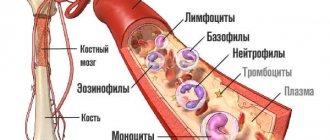Hemothorax is a subtype of hydrothorax, which involves the accumulation of blood in the pleural cavity. Blood enters the pleural cavity from the bronchial and pulmonary arteries. Blood flows out of damaged vessels until the pressure in the pulmonary vessels is balanced.
Acute total hemothorax often causes death due to blood loss and breakthrough of the blood mass into the abdominal cavity.
= =
Small hemothorax is dangerous due to the erasure of symptoms, blood infection and chronic organ ischemia.
Causes
The human pleural cavities do not communicate. Hemothorax can only occur on one side, without including the second lung in the process.
Reasons why hemothorax develops on the right or left:
- Malignant tumor in the pleural cavity.
- Pulmonary infarction. Often due to pulmonary embolism.
- Complication after catheterization of the right or left subclavian vein or iatrogenic hemothorax. Often, when the left subclavian vein is damaged, the thoracic lymphatic duct is affected, which leads to chylothorax or the release of lymph into the pleural cavity.
- Traumatic hemothorax due to a direct blow to the chest. Often accompanied by rib fractures, closed or open chest trauma.
Traumatic hemothorax is the reason for contacting and writing a statement to the police, since the injury is classified as grievous bodily harm.
Causes of occurrence and mechanisms of development
Depending on the cause of hemothorax, there are:
- traumatic – due to a chest injury;
- pathological - due to a pathological process that has developed in the wall or organs of the chest;
- iatrogenic – as a consequence of medical interventions;
- spontaneous - in which blood flows spontaneously into the pleural cavity, the reasons for this phenomenon have not been established.
Iatrogenic hemothorax is actually a type of traumatic hemothorax. Most often it occurs:
- after surgical interventions - due to too extensive forced tissue trauma, or if the bleeding was not stopped properly;
- during pleural puncture or thoracentesis, if they were performed with technical errors, or there were factors complicating the procedure;
- at the time of insertion of the catheter into the central venous vessel.
The following forms of hemothorax are distinguished separately:
- clotted - observed after surgical interventions, when the patient is given coagulant therapy according to indications (it is aimed at increasing blood clotting - in particular, to prevent bleeding). Due to the use of coagulants, blood discharge that enters the pleural cavity coagulates faster than with normal hemothorax ;
- pneumohemothorax - blood and air accumulate in the pleural cavity at the same time. It is observed in cases of traumatic rupture of the lung, melting of the focus of tuberculosis and injury to the chest with a sharp massive object.
Based on the attachment of an infectious agent, the following forms of hemothorax are distinguished:
- uninfected;
- infected. It is often observed with coagulated hemothorax, when the infection quickly “settles” on the intrapleural blood clot, and this, in turn, provokes a subsequent purulent process - pyothorax (pus in the pleural cavity) or pleural empyema (purulent diffuse lesion of the pleural sheets).
The list of the most common causes of hemothorax looks like this:
chest wounds - most often gunshot, knife, compression (if the chest was pressed by a heavy massive object);- rib fractures (as a result of an accident or too intense pulmonary-cardiac resuscitation);
- aortic aneurysm;
- pulmonary tuberculosis;
- malignant neoplasms of the chest wall or chest organs (lungs, pleura or mediastinal organs), especially at the stage of decay;
- lung abscess;
- deterioration of blood clotting properties (occurs with coagulopathy, hemorrhagic diathesis, and so on).
The immediate cause of hemothorax is a violation of the integrity of the vascular wall:
- chest;
- lung
Less commonly, hemorrhage occurs due to trauma to the vessels of the mediastinal organs - the thymus gland (or the fatty tissue that replaces it), that part of the aorta that is located outside the heart sac, trachea, esophagus, lymphatic ducts, blood vessels and nerve structures. They are partially covered by the lungs, which, when exposed to a traumatic factor, mainly take the blow.
Hemothorax is often unilateral. Bilateral damage occurs due to a pronounced traumatic factor:
- in production (when falling from a height);
- in case of accidents (road accidents);
- during natural disasters (due to house collapses);
- during hostilities;
- when playing sports (especially using strength methods).
Bilateral hemothorax in 90-95% of cases means severe. This is caused by damage:
- intercostal arteries;
- aorta;
- vena cava.
In these cases, the amount of blood poured into the pleural cavity can reach two liters or more. At first, blood fills the diaphragmatic pockets, but since the space of the pleural cavity is quite narrow, it fills quickly, the blood begins to compress one or both lungs, which is why they cannot expand normally.
Types of hemothorax
Hemothorax is classified according to the amount of blood loss, so the severity of the injury and the approximate prognosis of the patient can be determined. The volume of blood loss during hemothorax determines whether it is necessary to transfuse blood, albumin, or red blood cells.
Check out the table for the classification of hemothorax according to Kupriyanov.
| View | Volume of blood loss | Localization of blood in the pleural cavity |
| Small | Up to 500 ml | Blood is found exclusively in the pleural sinuses |
| Average | 500-1000 ml | Blood reaches the angle of the scapula |
| Total | From 1000 ml | Blood occupies almost the entire pleural cavity |
ATTENTION! In case histories of hemothorax, it is added whether bleeding into the pleural cavity continues or not.
Based on the location of blood in the pleural cavity, the following types are distinguished:
- apical,
- interlobar,
- paracostal (on the side of the ribs),
- supradiaphragmatic (in the sinuses),
- paramediastinal (near the sternum).
Types of hemothorax are taken into account in the medical history, as well as when choosing a puncture site.
Prevention
The occurrence of hemothorax is prevented by avoiding dangerous situations that can lead to chest trauma:
- household (fights, jumping into water in shallow water, as well as falling from a height - such cases especially become more frequent during harvesting from fruit and berry trees);
- industrial (collapses in the mine);
- during large-scale natural disasters (earthquakes, tornadoes, tornadoes);
- during hostilities.
If such injuries occur, an urgent consultation with thoracic surgeons is necessary, who will promptly determine the fact of bleeding into the pleural cavity and resort to actions to prevent the accumulation of blood discharge in the pleural cavity.
Important
Caution regarding hemothorax should also be exercised in case of abdominal wounds.
Also, prevention of hemothorax consists of preventing diseases that can cause it - primarily these are:
- aortic aneurysm;
- pulmonary tuberculosis;
- malignant neoplasms of the chest organs - especially advanced ones, at the stage of decay.
In order not to cause iatrogenic hemothorax, manipulations on the chest (in particular, those that are performed blindly, without visual control - these include pleural puncture and thoracentesis) must be performed extremely carefully and monitored for trauma to the structures of the chest with accompanying bleeding . The same applies to thoracic surgical interventions.
To prevent spontaneous hemothorax, you should react sensitively to any pathological changes in the respiratory system and signs of internal bleeding. By promptly fixing it and taking hemostatic measures, you can prevent the accumulation of blood in the pleural cavity that occurs during causeless pleural bleeding.
Clinic
With small hemothorax, the clinical picture is not pronounced. There are no changes in the cardiovascular and respiratory systems. If this happened due to a chest injury, then surgical intervention in the initial stages will not be required. If blood enters the cavity in small portions more than once, the risk of developing posthemorrhagic chronic anemia and iron deficiency increases.
Average hemothorax is characterized by symptoms:
- weakness,
- shortness of breath with difficulty inhaling,
- squeezing chest pain,
- cyanosis or blueness of the skin,
- cold sweat.
The patient has a rapid and weak pulse, rapid and shallow breathing, pale skin and mucous membranes.
A dry cough often occurs after movements, during which the pain intensifies.
Breathing is not audible on auscultation. Similar symptoms develop with closed pneumothorax. It is impossible to clinically distinguish the presence of air or blood in the pleural cavity. This can only be done using x-rays.
During the first 3-6 days, due to the absorption of blood by the pleural layers, the body temperature rises to 38-39 degrees Celsius. Then it gradually decreases. If the temperature persists for more than 10 days, this may indicate infection of the pleura and the onset of systemic inflammatory response syndrome (SIRS).
The clinic can be complicated by pneumothorax - air entering the pleural cavity or cardiac tamponade - blood entering the pericardium. The patient's condition is deteriorating, only surgical treatment and rapid evacuation of blood increase the patient's chances of survival.
Signs of hemothorax
A small hemorrhage into the pleural cavity may not be clinically apparent . It happens:
- in unexpressed pathological conditions of the chest wall and organs of the chest cavity, when small vessels were damaged, and after some bleeding spontaneously stopped;
- due to the more pronounced symptoms of the pathological process that led to the development of hemothorax and its symptoms suppress the signs of hemorrhage.
Severe hemothorax manifests itself:
- clinical symptoms from the respiratory system;
- general signs of the whole organism.
Respiratory signs:
a feeling of squeezing and heaviness in the chest. It may decrease if the patient lies down on the affected side or tries to take a semi-sitting position, in which blood discharge flows into the lower parts of the pleural cavity, their pressure on the lung tissue weakens;- shortness of breath (frequent shallow breathing);
- inability to take a deep breath;
- a feeling of lack of air (due to the exclusion of blood-compressed lung segments from the act of breathing);
- increased breathing (to compensate for the feeling of lack of air);
- bluish tint of the skin and visible mucous membranes. It is more pronounced and appears much faster than with hydrothorax, which is similar in volume to the fluid poured into the pleural cavity, since it will be caused not only by deterioration of ventilation of the compressed lung, but also by bleeding;
- at later stages, due to the addition of an infection, an increase in body temperature, first to subfebrile levels (37.0-37.3 degrees Celsius), then higher if a purulent process in the form of pyothorax or pleural empyema develops.
General signs of acute blood loss that appear with hemothorax:
- pallor and then cyanosis of the skin and visible mucous membranes (if compression of the lung appears earlier than the consequences of bleeding, pallor may not be observed, cyanosis is immediately recorded);
- increased sweating, sweat that feels cold to the touch;
- changes in hemodynamics (indicators characterizing the movement of blood through the vessels) - increased heart rate and pulse, hypotension.
Bilateral pneumothorax is regarded as an extremely unfavorable condition. Even if a small amount of blood initially spilled into both pleural cavities, the bleeding may recur and be more pronounced, due to which both lungs will be compressed by the spilled blood, and this will lead to respiratory decompensation. With massive bilateral hemothorax, death can occur literally within a few minutes of its occurrence .
Diagnostics
An observation x-ray is taken. The following signs of hemothorax are detected on x-ray within 5 minutes:
- collapse of the lung (the X-ray shows a decrease in its area due to compression by blood),
- horizontal level of fluid, which is visible as a band of darkness (can be at the level of the sinuses or higher, up to the collarbones),
- shift or flotation of the mediastinum (trachea, heart) to the healthy side.
The darkening on the x-ray is shown as light or white due to the fact that the image itself is negative.
X-ray signs of hemothorax are clearly visible, the study itself is carried out even in paramedic stations and remote villages, and is completed within 5 minutes. This research is cheap.
If the lung is cleared above the horizontal darkening strip, it means that hemothorax is accompanied by pneumothorax, and there is both air and blood in the cavity. The condition is an emergency and is classified as causing grievous harm in the event of injury.
Auxiliary research methods, in addition to x-rays for hemothorax: a general blood test with severe anemia, a decrease in the number of red blood cells, hemoglobin, hematocrit.
During puncture of the pleural cavity: if the resulting blood has clotted, this means that bleeding continues. That is, the Rivilois-Gregoire test is positive. If it does not clot, then the process of fibrinolysis has begun in the pleural cavity, and new blood does not flow. The incoming blood must be pumped out in full.
DIAGNOSIS OF PLEURAL EFFUSIONS
The paper considers differential diagnosis of pleural exudates, presents a stepped scheme of etiological diagnosis of exudate in terms of the capacities of a multidisciplinary hospital, gives an algorythm of a physician's actions while diagnosing the exudate, lists all main causes of abnormal accumulation of fluid in the pleural cavity. S.L. Malanichev, G.M. Shilkin.
Department of Pulmonology SPGM and M, Moscow SL Malanichev, GM Shilkin Department of Pulmonology, SPHWM, Moscow
N
Despite the rich experience accumulated by domestic and foreign medicine in the diagnosis, tactics of management and treatment of exudative pleurisy, they still remain a problem in terms of establishing their etiology.
| Pleural effusion is the accumulation of pathological fluid in the pleural cavity due to inflammatory processes in adjacent organs or layers of the pleura or when there is a violation of the relationship between the colloid-osmotic pressure of the blood plasma and the hydrostatic pressure in the capillaries. |
The symptoms of pleural effusion are varied and are largely determined by the pathological process that caused it and the amount of fluid in the pleural cavity. The main symptoms of pleural effusion are a dry cough, shortness of breath and a feeling of heaviness on the affected side. Pleural or aching pain in the chest indicates an inflammatory process in the parietal pleura, although convincing data have been obtained on the presence of “nonspecific nociceptors” in the lungs and other organs and their important role in the occurrence of visceral pain (A. Malliani, F. Lombardi, 1982; H Blumberg et al., 1983). A small pleural effusion does not have a significant effect on lung function and may not cause clinical symptoms. Determining the presence of pleural effusion using physical examination methods,
as a rule, does not cause difficulties.
Shortening of the pulmonary tone, weakening of voice tremors and breathing on the affected side most likely indicate the presence of a significant amount of fluid in the pleural cavity. The next step is an x-ray examination
, which makes it possible to clarify the presence, localization of effusion and the condition of the mediastinal organs. The location of the effusion is not critical, although right-sided location is more common for congestive effusions. With massive effusions, it is important to pay attention to the position of the mediastinum. If there is a tumor or infiltrative process in the mediastinum, it will be recorded. A shift towards the effusion indicates that the lung on the side of the effusion is affected and the shift is due to its hypoventilation or atelectasis.
| Causes of pleural effusion | |||
| Basic | Less frequent | ||
| Transudates | Heart failure | Nephrotic syndrome Cirrhosis Peritoneal dialysis Myxedema | |
| Inflammatory (infectious) exudates | Parapneumonic effusion Tuberculosis | Subphrenic abscess Viral infection Fungal infections | |
| Inflammatory exudates (non-infectious) | Pulmonary embolism | Collagenosis Pancreatitis Reaction to medications Asbestosis Dressler's syndrome Yellow nail syndrome | |
| Tumor exudate | Cancer metastases Lymphoma | Mesothelioma Meigs syndrome | |
| Hemothorax | Injury | Spontaneous (hemostasis disorders) | |
| Chylothorax | Lymphoma Carcinoma Trauma | Lymphangioleomyomatosis | |
With massive pleural effusion, as a rule, metastatic damage to the pleura is likely, which, however, also occurs with congestive effusions, less often with tuberculous ones. In all cases of darkening of the posterior costophrenic sinus or blurred contour of the diaphragm, the presence of effusion in the pleural cavity should be assumed. Sometimes, for unknown reasons, a significant amount of fluid accumulates above the lower lobe of the lung, without passing into the costophrenic sinus. This type of collection is called supradiaphragmatic, or basal, pleural effusion.
| Pleural fluid examination | ||
| Transudate | Exudate | |
| Appearance of liquid | Transparent | Transparent, cloudy, bloody |
| Protein Absolute amount | <30 g/l | >30 g/l |
| Pleural fluid/plasma ratio | < 0,5 | >0,5 |
| LDH Absolute amount Pleural fluid/plasma ratio | <200 U/l <0,6 | >200 U/l >0,6 |
| Glucose level | >3.33 mmol/l | Variable, often <3.33 mmol/l |
| Leukocytes (polymorphonuclear) | <50% | Typically >50% in acute inflammation |
| Red blood cell count | <5000 in 1 ml | Variable |
X-ray is determined by the high position of the dome of the diaphragm, and in the case of left-sided localization, the lower border of the lung is located further than usual from the air bubble in the stomach. Clinical and radiological suspicion of basal effusion is important, since this is an indication for examining the patient in the supine position. An atypical location of the effusion is possible due to changes in the elastic traction of the affected area of the lung. Atypical accumulation of fluid indicates that, in addition to inflammation of the pleural layers, there is a disease of the parenchyma. As a result of the adhesive process, fluid can encyst anywhere between the parietal and visceral pleura or in the area of interlobar fissures. Most often this is associated with acute bacterial infections. The encysted fluid in the interlobar fissures is usually visible in lateral views and resembles a biconvex lens. Ultrasound can sometimes be used to differentiate between encysted pleural effusions, atelectasis, and pulmonary tissue infiltrates, which can also help determine the site of thoracentesis for encysted and small effusions.
If there is a horizontal fluid level on radiographs, a differential diagnosis is made between encysted pyopneumothorax, hydropneumothorax and peripheral lung abscess. The horizontal level of fluid in the pleural cavity indicates the presence of air. The next, perhaps most important, stage of diagnosis is thoracentesis.
, which is performed to differentiate exudative and transudative effusions, study the cellular composition of pleural fluid and assess the condition of the lung. Diagnostic thoracentesis is indicated for patients in whom the thickness of the fluid layer on radiographs in the lateral decubitus position is more than 10 mm or there is an encysted pleural effusion identified by ultrasound (R.U. Light, 1986). Depending on the color, transparency, relative density, biochemical and cytological composition, two types of pleural effusions are distinguished - exudate and transudate. In addition, accumulation of blood (hemothorax) and lymph (chylothorax) is possible in the pleural cavity. Transudate is a clear, yellowish liquid with a relative density of 1.015, low protein content (less than 20 g/l) and no tendency to clot during prolonged standing. Transudate is characterized by low, less than 1.6 mmol/(l.g), lactate dehydrogenase (LDH) activity, the ratio of effusion LDH to serum LDH is below 0.6, the ratio of effusion protein to serum protein is below 0.5 (V.G. Grigoryan et al., 1986). The accumulation of transudate in the pleural cavity is called hydrothorax. Most transudates and some exudates are transparent, straw-yellow in color, non-viscous and odorless. Increased viscosity of pleural fluid indicates an increased content of hyauuronic acid, which occurs in patients with pleural mesothelioma. Reddish or brownish pleural fluid indicates the presence of blood in it, which is fresh or has been there for a long time. Cloudy pleural effusion, which has a milky coloration, indicates the presence of chylothorax. Sometimes chylous effusion can be mistaken for pleural empyema. Centrifugation of fluid from the pleural cavity brings clarity. Chylous effusion remains cloudy. Although the type of pleural effusions does not have a decisive diagnostic value, nevertheless, after distinguishing them into exudate and transudate, it is possible to imagine an approximate spectrum of etiological affiliation.
I. Transudative pleural effusions
1) congestive heart failure; 2) pulmonary embolism; 3) nephrotic syndrome (glomerulonephritis, lipoid nephrosis, renal amyloidosis, etc.); 4) cirrhosis of the liver; 5) myxedema.
II. Exudative pleural effusions Due to neoplasms
1) primary pleural tumor (mesothelioma); 2) metastatic tumors; 3) leukemia.
Due to infectious diseases
1) tuberculosis; 2) bacterial infections; 3) fungal infections; 4) parasitic infections.
Due to diseases of the gastrointestinal tract
1) enzymatic (pancreatogenic); 2) intrahepatic or subphrenic abscess.
Due to diffuse connective tissue diseases
1) rheumatism; 2) rheumatoid arthritis; 3) systemic lupus erythematosus.
Due to other diseases and conditions
1) post-infarction Dressler syndrome; 2) Meigs syndrome; 3) “yellow nails” syndrome (congenital hypoplasia of the lymphatic system; thickened and curved yellow nails, primary lymphedema, less often exudative pleurisy, bronchiectasis are characteristic), 4) drug allergies; 5) asbestosis; 6) uremia; 7) chest injuries; hematox; 9) chylothorax.
2) Meigs syndrome; 3) “yellow nails” syndrome (congenital hypoplasia of the lymphatic system; thickened and curved yellow nails, primary lymphedema, less often exudative pleurisy, bronchiectasis are characteristic), 4) drug allergies; 5) asbestosis; 6) uremia; 7) chest injuries; hematox; 9) chylothorax.
The next stage is the study of the cellular composition of the pleural fluid.
Hemorrhagic exudate contains a significant admixture of fresh and altered red blood cells, and its interpretation from a diagnostic point of view is of the greatest interest.
According to I.B. Levi, A.A. Litvinova (1976), with hemorrhagic effusions, tumor processes are diagnosed in 71% of patients, and with the progression of the tumor process, hemorrhagic effusion can occur in 78% of patients. The presence of neutrophils in the pleural fluid, cells involved in the reaction to acute inflammation, is characteristic of pneumonia and subdiaphragmatic abscess. If they make up more than 20% of the total cellular composition, then this is indicative of the early stages of tuberculosis. The presence of 6 - 10% eosinophils is sufficient to diagnose eosinophilic effusion. Eosinophilic exudate can occur in pneumonia, diffuse connective tissue diseases, helminthic infestations, fungal diseases, and injuries (P.G. Kalmykov, G.S. Pervomaisky, 1979; IFBeekman et al., 1974). The presence of eosinophils in parapneumonic effusion is a good prognostic sign. This effusion rarely becomes infected. In most cases, eosinophilia of pleural fluid is caused by the presence of air or blood in the pleural fluid (R.W. Light, 1986). If the exudative pleural effusion contains more than 50% lymphocytes, this is an important diagnostic sign, suggesting that the patient has tuberculosis or a malignant disease. Detection of mesothelial cells in pleural fluid may have some diagnostic value. The presence of mesothelial cells is not typical for tuberculous and parapneumonic effusions. The largest number of mesothelial cells was observed in pulmonary infarction, cardiac and renal failure (W. Matzel, 1970). Macrophages, basophils and plasma cells detected in pleural fluid have no diagnostic value. The methods used to determine pleural fluid proteins, such as carcinoembryonic antigen and orosomucoid, have diagnostic value; however, their use is not possible in every laboratory. biopsy
is indicated for the diagnosis of malignant or tuberculous pleural effusion.
To obtain pathological material, three types of pleural biopsy are used: thoracoscopic, surgical and puncture. Histological examination of biopsy samples of the parietal pleura allows one to verify the diagnosis in 60-93% of patients with tuberculosis and 70% of patients with metastatic pleurisy (N.S. Tyukhin et al., 1984). Thoracoscopy
is used in those patients in whom, as a result of bronchoscopy, analysis of pleural fluid and pleural biopsy, the etiology of the pleural effusion remains unclear. Lung scanning is recommended in patients with pleural effusion, the etiology of which is not established after initial diagnostic studies are performed to exclude thromboembolism of the branches of the pulmonary artery. Based on the experience of our predecessors, literature data and our own practice, we tried to briefly outline the main points of the approach to establishing the etiology of pleural effusion. However, despite the abundance of methods, establishing the etiology of pleural effusion is a certain difficulty and to a certain extent depends on the experience, intuition of the practitioner and the diagnostic capabilities of the medical institution.
Literature:
1. Pain syndrome. Ed. V.A. Mikhailovich, Yu.D. Ignatova. L.: Medicine, 1990. 336 p. 2. Light R.U. Diseases of the pleura. Per. from English M. Medicine, 1986. 370 p. 3. Grigoryan V.G., Kiryushina V.S., Shinkareva T.I., Tsimbalar G.G. The significance of some biochemical parameters in the clinic of tuberculosis. Chisinau: Shtintsa, 1986. 141 p. 4. Levi I.B., Litvinov A.A. Clinical characteristics of exudative pleurisy of various etiologies. Problem tube 1976, p. 60-2. 5. Kalmykov P.G., Pervomaisky T.S. Helminthiases. Tropical diseases. Ed. E.P. Shuvalova. M.: Medicine, 1979. p. 419-33. 6. Beekman IF, Dosniak S., Canter HG. Eosinophilia and elevated g E concentration in a serous pleural effusion following trauma // Amer. Rev. resp. Dis. - 1974. - Vol. 110, No. 4 - R. 484-9. 7. Tyukhtin N.S., Berlova Z.D., Shvedov G.I. Diagnosis and treatment of patients with tuberculous exudative pleurisy. Problem tube - 1984. - No. 5 - p. 16. 8. Respiratory diseases: A guide for doctors in 4 volumes. Ed. N.R. Paleeva. T.2. Private pulnomology. pp. 344-55.
Treatment
Traumatic or hemothorax of another origin requires immediate treatment. Therapy is not always limited to drainage of the pleural cavity. The treatment strategy for hemothorax is to identify and treat the cause, for example, antitumor therapy.
If the hemothorax is small and there is less than 500 ml of blood in the pleural cavity, then no special treatment is required. The liquid will be absorbed by the pleural layers on its own within 7-10 days. The patient will need to have a repeat x-ray to make sure there is no blood and not clotting in the cavity.
If the hemothorax is medium or large, surgical treatment in a hospital is necessary. With this pathology, the patient is treated by a thoracic surgeon. Only he can perform manipulations to drain the pleural cavity; this is not the competence of a paramedic or nurse.
After pumping out the blood using a syringe, it is necessary to rinse the pleural cavity with saline until it becomes slightly pink or colorless. Then the puncture site is re-treated with an antiseptic and a bandage is applied. The dressing is changed once a day. If infection of the contents in the cavity occurs, antibiotics from the cephalosporin group can be administered with saline solution: Ceftriaxone, Cefotaxime or macrolides.
If simple drainages are ineffective, active or passive drainage according to Bulau from the 7th or 8th intercostal space is used.
First aid
For moderate or total hemothorax, pleural puncture is performed. Emergency assistance in the form of drainage of the pleural cavity is provided by a doctor.
If bleeding continues after puncture, as well as when more than 1000 ml of blood is removed through drainage at a time, it is necessary to perform an emergency thoracotomy, dissection of the chest with a search for the bleeding vessel and its ligation, and suturing the wound. Sometimes it is necessary to excise the damaged lung.
As maintenance therapy, venous catheterization and restoration of blood volume are performed. Hemostatic drugs are prescribed: tranexamic or aminocaproic acid, calcium gluconate.
THIS IS INTERESTING! If the patient's blood, which spilled into the pleural cavity less than 1 hour ago, is not infected with microbes, reinfusion can be performed. To determine the infection or purity of blood, Petrov and Efendiyev tests are performed. Anticoagulants are added to uninfected blood and infused intravenously into the patient.
Puncture
Recommendations for surgical tactics during puncture for hydrothorax, including hemothorax or chylothorax:
- puncture site – 6-7 intercostal space,
- puncture line – between the posterior and middle axillary lines,
- injection site, the upper edge of the previous rib to prevent puncture of the intercostal vessels.
- patient's position - lying or sitting.
Complications
Hemothorax involves the release of blood into the pleural cavity. Because of this, pressure on the lungs in the pleural cavity may increase, causing pain in the pleural points.
Then respiratory failure due to the fact that it is difficult for the lungs to expand when inhaling. Shortness of breath occurs during physical activity or at rest.
The blood that is in the cavity can clot, and adhesions begin to form between the layers of the pleura. They arise due to the action of fibrin threads, a blood plasma protein. The condition is called clotted hemothorax or "h. concretus" in Latin, this often occurs when there is little blood output.
The adhesive process develops into limited mobility of the pleura and respiratory failure. Over time, it will be difficult and painful for the patient to inhale and exhale. Less oxygen will enter the tissues, and a state of chronic ischemia .
Regardless of the severity of hemothorax, harm to health is caused by blood infection . If bacteria enter the blood or they begin to multiply, the patient’s temperature rises, pain intensifies and abscesses form . Abscesses worsen respiratory failure, they spread throughout the pleural cavity and cause blood poisoning or sepsis. The final condition is pleural empyema or pleural fibrosis.
CAREFULLY! Less than 1 week may pass from the moment of infection to the moment of generalized sepsis.
Forecast
With intrapleural bleeding starting from moderate severity, the prognosis can be complex and depends on:
- the severity of the chest lesion that caused the hemothorax;
- rate and duration of blood loss;
- timeliness of diagnostic and therapeutic measures.
The prognosis for bilateral hemothorax is always more difficult. Even if the bleeding is slight, it can become much more intense at any moment. Since both halves of the chest are affected, respiratory decompensation will occur. Also, the severity of the prognosis is aggravated by the coagulated form of hemothorax. The most pessimistic prognosis is for bilateral traumatic coagulated hemothorax with ongoing bleeding. It more often than other types of hemothorax leads to:
- death;
- and if the patient survives - to protracted complications, the relief of which requires more time and more resources both from the patient’s body and from doctors.
The prognosis for life is favorable if the diagnosis and treatment of hemothorax were carried out in the first hours from the moment of its occurrence. After hemothorax, the health prognosis will be favorable if the patient is properly rehabilitated. To avoid late complications (formation of adhesions in the pleural cavity that impair breathing), patients should begin as soon as possible:
- regular swimming lessons;
- race walking;
- performing special breathing exercises.
After suffering a hemothorax, you should expect that the recovery will be long - sometimes it takes at least a year to finally get rid of the consequences of hemothorax.
Kovtonyuk Oksana Vladimirovna, medical observer, surgeon, consultant doctor
22, total, today
( 186 votes, average: 4.60 out of 5)
Burns from boiling water: degrees, first aid and treatment
Drug overdose (poisoning): symptoms, first aid
Related Posts
Results
- Hemothorax is an injury that leads to complications: blood infection and pleural empyema, respiratory failure and lung collapse, adhesions, chest resistance.
- According to topographic anatomy, bleeding occurs from the bronchial or pulmonary arteries due to injury, cancer, or against the background of lung collapse.
- There are small medium and large hemothorax according to Kupriyanov, the types of pathological condition are based on the amount of blood loss.
- The clinical picture or symptoms are characterized by weakness, shortness of breath, cold sweat, cough. The patient has difficulty inhaling or exhaling.
- The x-ray shows a horizontal fluid level, mediastinal displacement, and lung collapse.
- The main surgical tactics and emergency care consists of draining the pleural cavity after puncture with a thick needle in the 6-7 intercostal space.










